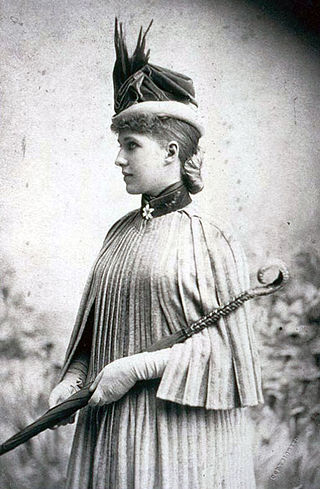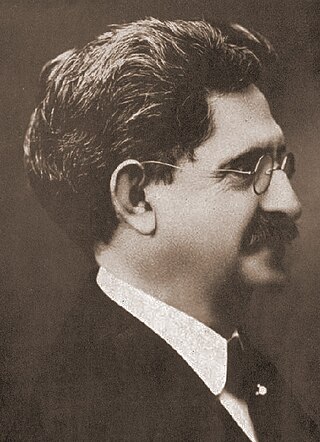
The George C. Marshall Space Flight Center (MSFC), located in Redstone Arsenal, Alabama, is the U.S. government's civilian rocketry and spacecraft propulsion research center. As the largest NASA center, MSFC's first mission was developing the Saturn launch vehicles for the Apollo program. Marshall has been the lead center for the Space Shuttle main propulsion and external tank; payloads and related crew training; International Space Station (ISS) design and assembly; computers, networks, and information management; and the Space Launch System. Located on the Redstone Arsenal near Huntsville, MSFC is named in honor of General of the Army George C. Marshall.

John Jacob Astor IV was an American business magnate, real estate developer, investor, writer, lieutenant colonel in the Spanish–American War, and a prominent member of the Astor family. He was among the most prominent American passengers aboard RMS Titanic and perished along with 1,500 people when the ship sank on her maiden voyage. Astor was the richest passenger aboard the RMS Titanic and was thought to be among the richest people in the world at that time, with a net worth of roughly $87 million when he died.

The Saturn family of American rockets was developed by a team of former German rocket engineers and scientists led by Wernher von Braun to launch heavy payloads to Earth orbit and beyond. The Saturn family used liquid hydrogen as fuel in the upper stages. Originally proposed as a military satellite launcher, they were adopted as the launch vehicles for the Apollo Moon program. Three versions were built and flown: the medium-lift Saturn I, the heavy-lift Saturn IB, and the super heavy-lift Saturn V.
The Space Odyssey series is a series of science fiction novels by the writer Arthur C. Clarke. The first novel was developed concurrently with Stanley Kubrick's film version and published after the release of the film. The second was made into a feature film, released in 1984, respectively. Two of Clarke's early short stories have ties to the series.
The naming of moons has been the responsibility of the International Astronomical Union's committee for Planetary System Nomenclature since 1973. That committee is known today as the Working Group for Planetary System Nomenclature (WGPSN).

Planetary romance is a subgenre of science fiction in which the bulk of the action consists of adventures on one or more exotic alien planets, characterized by distinctive physical and cultural backgrounds. Some planetary romances take place against the background of a future culture where travel between worlds by spaceship is commonplace; others, particularly the earliest examples of the genre, do not, and invoke flying carpets, astral projection, or other methods of getting between planets. In either case, it is the planetside adventures which are the focus of the story, not the mode of travel.

2001: A Space Odyssey is a 1968 science fiction novel by British writer Arthur C. Clarke. It was developed concurrently with Stanley Kubrick's film version and published after the release of the film. Clarke and Kubrick worked on the book together, but eventually only Clarke ended up as the official author. The story is based in part on various short stories by Clarke, including "The Sentinel". By 1992, the novel had sold three million copies worldwide. An elaboration of Clarke and Kubrick's collaborative work on this project was made in the 1972 book The Lost Worlds of 2001.

Jupiter, the largest planet in the Solar System, has appeared in works of fiction across several centuries. The way the planet has been depicted has evolved as more has become known about its composition; it was initially portrayed as being entirely solid, later as having a high-pressure atmosphere with a solid surface underneath, and finally as being entirely gaseous. It was a popular setting during the pulp era of science fiction. Life on the planet has variously been depicted as identical to humans, larger versions of humans, and non-human. Non-human life on Jupiter has been portrayed as primitive in some works and more advanced than humans in others.

Saturn has made appearances in fiction since the 1752 novel Micromégas by Voltaire. In the earliest depictions, it was portrayed as having a solid surface rather than its actual gaseous composition. In many of these works, the planet is inhabited by aliens that are usually portrayed as being more advanced than humans. In modern science fiction, the Saturnian atmosphere sometimes hosts floating settlements. The planet is occasionally visited by humans and its rings are sometimes mined for resources.
The Grand Tour is a series of novels written by American science fiction author Ben Bova.

Princess Amélie Rives Troubetzkoy was an American author of novels, poetry, and plays. The Quick or the Dead? (1888), her first novel, which sold 300,000 copies, created more of a sensation than any of her later work. Her 1914 novel, World's End was reputed to be "the best seller in New York City". Described as a genius who was morbidly sensitive, she was a woman of moods and fancies, but in manner, as simple as a child.
For the silent film see The Great Romance (film)
The Milltillionaire, or Age of Bardization is a work of utopian fiction written by Albert Waldo Howard, and published under the pseudonym "M. Auberré Hovorré." The book was one element in the major wave of utopian and dystopian literature that characterized the final decades of the nineteenth century.

Annals of the Twenty-Ninth Century: or, The Autobiography of the Tenth President of the World-Republic is a science fiction novel written by Andrew Blair, and published anonymously in 1874.

Arena Publishing Company was an American book and magazine publishing firm of the late 19th century, founded by author and editor B. O. Flower.
Journey to Mars the Wonderful World: Its Beauty and Splendor; Its Mighty Races and Kingdoms; Its Final Doom is an 1894 science fiction novel written by Gustavus W. Pope. The book has attracted increased contemporary attention as a precedent and possible source for the famous Barsoom novels of Edgar Rice Burroughs. A sequel, Journey to Venus, followed in 1895.
Journey to Venus the Primeval World; Its Wonderful Creations and Gigantic Monsters is an 1895 science fiction novel written by Gustavus W. Pope. The book was a sequel to Pope's novel of the previous year, Journey to Mars. The Venus volume features the same hero and heroine, Lt. Frederick Hamilton, USN, and his love interest the Martian princess Suhlamia. They travel to Venus on a Martian "ethervolt" spacecraft.

A Honeymoon in Space is a 1901 novel by George Griffith. It was originally serialized in abridged form in Pearson's Magazine in 1900 under the title Stories of Other Worlds. The scientific romance story depicts a tour of the Solar System, a type of story that was in vogue at the time.
A Narrative of the Travels and Adventures of Paul Aermont among the Planets is an 1873 science fiction novel published under the pseudonym "Paul Aermont", the story's fictional main character who travels the Solar System in a balloon. After its initial publication, the book largely fell into obscurity and did not see a reprint until 2018.













